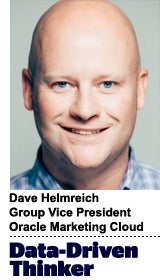“Data-Driven Thinking” is written by members of the media community and contains fresh ideas on the digital revolution in media.
Today’s column is written by Dave Helmreich, group vice president at Oracle Marketing Cloud.
As the popularity of mobile shopping continues to skyrocket, there’s one key thing to remember: While the outcome is the same for consumers – a great purchase – the experience and how they approach it is vastly different.
Even as retailers embrace digital and mobile, most are not investing quickly enough to keep pace with the speed of technology change or consumer expectations. Experience analytics – in this case, insights into how users tap and scroll, pause and search – can help brands better understand consumers’ mobile buying experiences, which can, in turn, enable them to market to consumers more effectively.
For most mobile shoppers, convenience is everything. It’s so important that, according to a recent study, 37% of consumers say they are happy to pay more for a product or service if the mobile shopping experience is better. With the average shopping cart abandonment rate at 70%, there is a significant and adverse impact to retail performance if the shopping experience is suboptimal.
Most marketers know that the mobile experience needs to be slick in terms of speed. Google found that 53% of visits are abandoned if the page doesn’t load within three seconds, and conversions fall by up to 20% for every second of page load time.
But, perhaps the most important area is understanding the intent behind consumer decisions on mobile devices. It’s possible to determine what an online shopper is interested in buying if they have a wish list. Other clues that indicate intent to purchase include searching for similar search terms, searching multiple times within the same category, multiple visits to the same page, clicking on different products in the same category and social sharing, pinning, posting a picture or discussing a product. A shoe retailer, for example, could tell that I’ve viewed its website three times in one week while shopping for a gift for my wife. As a result, the company might trigger an email campaign including a $10 coupon to help finalize the sale.
Any of these data points or behaviors can be used to trigger email, product recommendations or online merchandising campaigns that are more relevant and likely to convert. They can also provide key data about a customer’s interests and can help marketers personalize shoppers’ experiences. Personalization around marketing messages across channels and service interactions can drastically improve the whole shopping experience.
As a consumer, I expect American Express to recognize me when I call from my phone number, and I expect USAA to remember where I left off in a transaction. It is this expected consumer experience that delights us but also frustrates us when it is done poorly.
Companies are still trying to implement new types of analytics tools to drive personalization. Walmart, for example, is leveraging analytics to make online and mobile shopping a more seamless experience. The store’s Easy Reorder tool gives shoppers visibility to their past in-store and digital purchases and allows them to seamlessly reorder in seconds. Nuanced data, such as what else might have been in the shopping cart at the time of purchase, could lead to deeper insight on customer behavior.
CPG companies often use trade analytics to gauge how promotions for individual products are performing. These promotions may include things like special discount pricing or eye-catching in-store displays. By working with sales teams and retailers, a CPG can use these analytics to determine how and where the promotions are working and how to optimize them in the future for more strategic pricing and increased demand.
To thrive in a mobile-first future, smart companies must balance their investments in customer-facing mobile technologies and experiential improvements with a commitment to fostering the organizational capabilities needed to provide a unified omnichannel shopping experience.
Follow Oracle Marketing Cloud (@OracleMktgCloud) and AdExchanger (@adexchanger) on Twitter.













